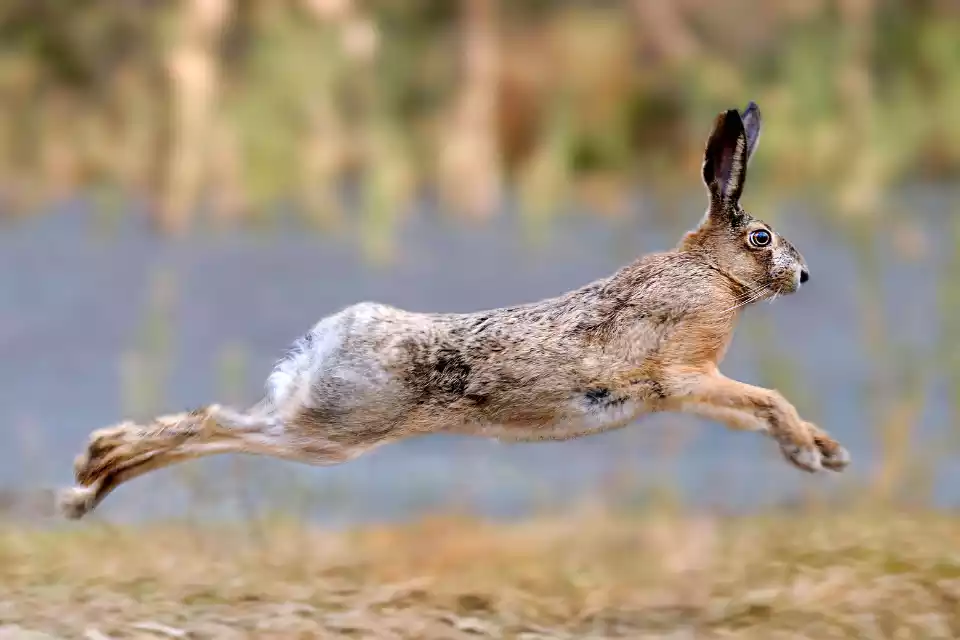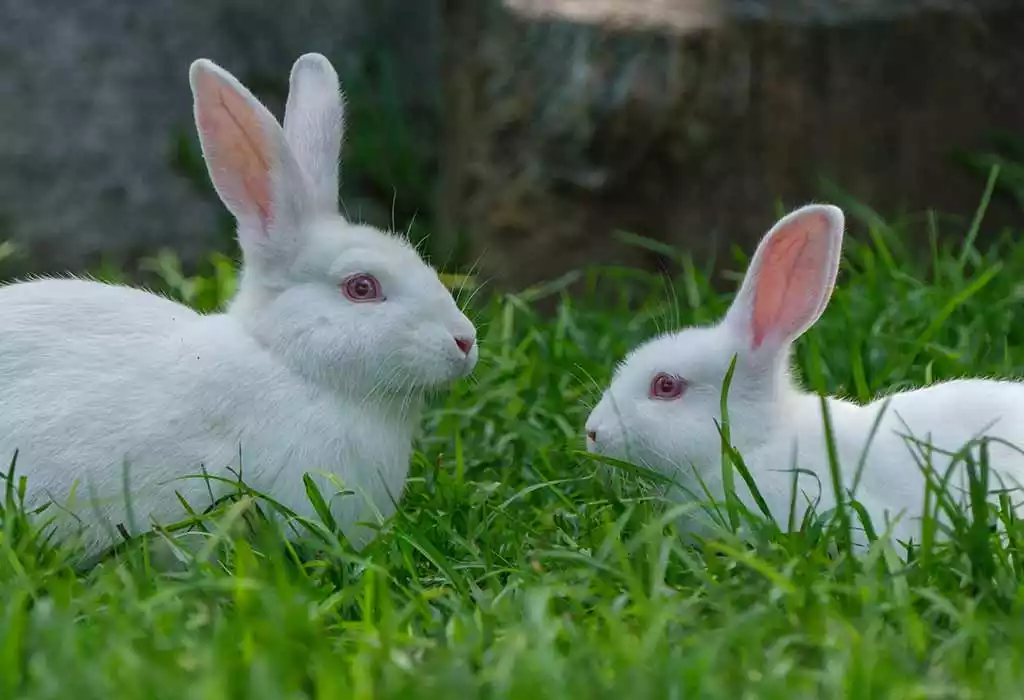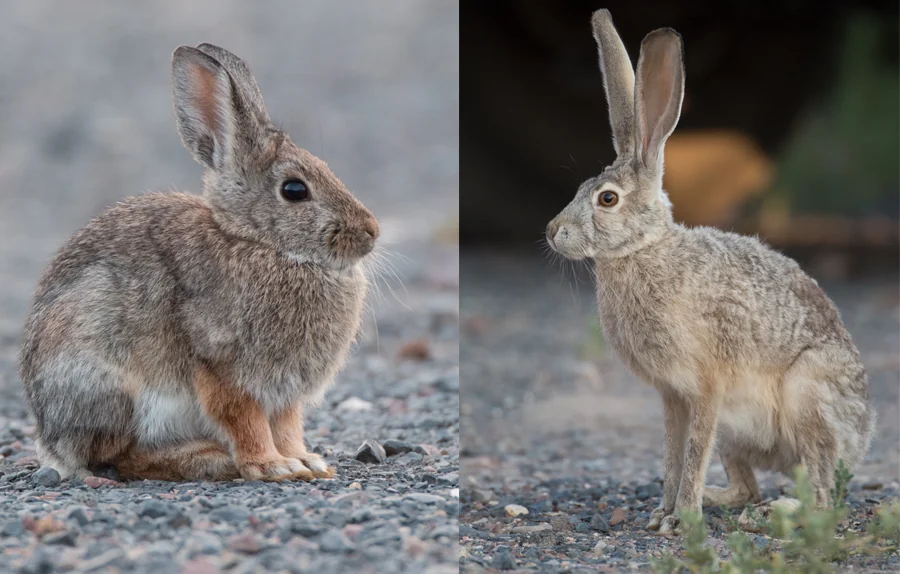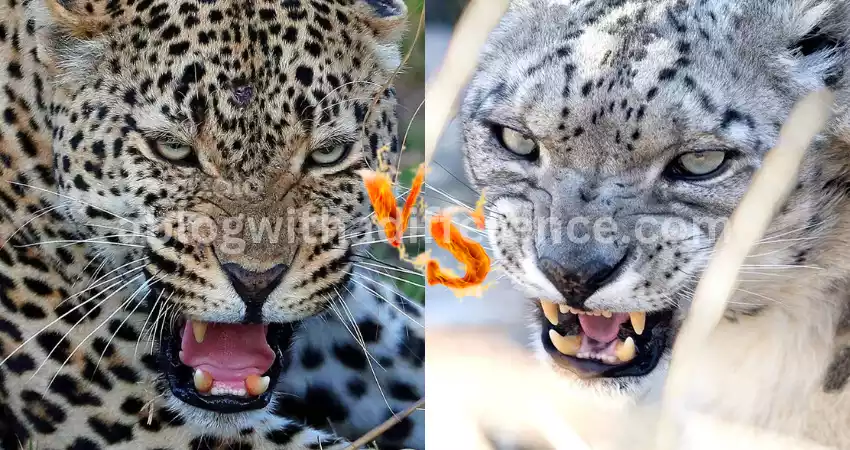Difference Between Hare vs Rabbit
Hares and rabbits, while similar in appearance, have distinct differences. Hares are generally larger, with longer ears and hind legs compared to rabbits. They are born with fur and their eyes open, making them more independent from birth.
In contrast, rabbits are smaller, with shorter ears and a burrowing lifestyle. They give birth to blind, hairless young, known as kits, which are dependent on their mother. Hares are adapted to open environments like fields and prairies, showcasing incredible speed and agility to evade predators.
Rabbits are more adapted to living in groups and use burrows for shelter and protection. Despite their differences, both belong to the family Leporidae and are herbivorous, feeding on grass and other vegetation.
Definition of Hare
A hare is defined as a fast-running, long-eared mammal that resembles a large rabbit, belonging to the family Leporidae. Unlike rabbits, hares are born with fur and can see, making them more independent from birth.

They typically have very long hind legs and long ears, and they are known for their swift and agile movements. Hares do not dig burrows but nest in slight depressions in the ground.
They are mainly nocturnal and are herbivores, feeding on grass and other vegetation. The term “hare” is also used for various species within this group, such as the European hare and the snowshoe hare.
Definition of Rabbit
A rabbit is a small, burrowing mammal belonging to the family Leporidae, known for its long ears, large hind legs, and short fluffy tail. Distinct from hares, rabbits are born hairless and with their eyes closed, making them dependent on their mothers for an initial period.

They are well-known for living in intricate burrows, or warrens, and for their social behavior, often living in groups. Rabbits are herbivores, primarily feeding on grass, forbs, and leafy weeds. They have a high reproductive rate, which is a characteristic feature of many rabbit species.
Rabbits are found in various parts of the world and are also popular as domesticated pets. In the wild, they play a significant role in the ecosystem as prey for a variety of predators and as grazers influencing plant communities.
Comparison table of Hare vs Rabbit
Here’s a comparison table outlining the key differences between hares and rabbits:
| Feature | Hare | Rabbit |
|---|---|---|
| Size | Generally larger | Smaller in comparison |
| Ears | Longer ears | Shorter ears |
| Legs | Longer hind legs | Shorter hind legs |
| Birth | Born with fur, eyes open (precocial) | Born hairless, eyes closed (altricial) |
| Independence at Birth | More independent, can move and fend for themselves shortly after birth | Dependent on mother, stay in the nest |
| Lifestyle | Solitary, do not burrow, live in simple nests above ground | Social, live in burrows or warrens |
| Movement | Very fast and agile, can run up to speeds of 70 km/h (45 mph) | Less speedy, rely more on hiding and burrowing |
| Habitat | Prefer open fields, grasslands, and prairies | Found in a variety of habitats, including woods, forests, meadows, and even deserts |
| Predator Evasion | Rely on speed and camouflage | Rely on burrows and hiding |
| Diet | Herbivorous, feeding on grasses and herbs | Herbivorous, primarily grass, forbs, and leafy weeds |
This table highlights the physical and behavioral distinctions between hares and rabbits, which, despite their similarities, are adapted to different lifestyles and environments.
Physical Characteristics
The physical characteristics of hares and rabbits have several distinctions, reflecting their different lifestyles and habitats:
Hare
- Size: Generally larger than rabbits.
- Body Shape: Slimmer, more athletic build.
- Fur: Often coarser and more varied in color, providing camouflage in open landscapes.
- Ears: Longer and sometimes with black markings.
- Legs: Very long and strong hind legs, adapted for fast running.
- Eyes: Larger and positioned to provide a wide field of vision, aiding in spotting predators in open areas.
- Tail: Generally longer and often black on top.
- Coloration: Usually changes seasonally, especially in species like the snowshoe hare (white in winter, brown in summer).
Rabbit
- Size: Smaller compared to hares.
- Body Shape: Stockier build.
- Fur: Softer and denser, often uniform in color.
- Ears: Shorter and without black markings.
- Legs: Shorter hind legs, suited for burrowing and hopping rather than sprinting.
- Eyes: Positioned more on the sides of the head, providing a broad field of vision to watch for predators from a hiding place.
- Tail: Known as a “cottontail” for its fluffy, white underside in many species.
- Coloration: Generally remains constant throughout the year.
Both animals are adapted to their specific environments – hares to open spaces where speed is essential for survival, and rabbits to more covered habitats where burrowing and hiding are key. Despite these differences, they share the common traits of long ears, a short tail, and strong hind legs characteristic of the Leporidae family.
Habitat and Behavior
The habitat and behavior of hares and rabbits reflect their adaptations to different environments and survival strategies.
Hare
Habitat
- Environment: Hares are typically found in open and semi-open landscapes such as fields, meadows, and prairies.
- Shelter: Instead of burrowing, hares rest in slight depressions in the ground or in dense vegetation, known as forms. These forms provide some concealment and protection from the elements and predators.
Behavior
- Social Structure: Generally solitary or living in pairs, hares are less social than rabbits.
- Activity: Mostly nocturnal or crepuscular (active during twilight), which helps avoid predators.
- Defense Mechanisms: Rely on their incredible speed and agility to escape predators. They are capable of sudden, zigzag running patterns and long jumps.
- Reproduction: Hares have seasonal breeding periods, and their young are born fully furred and with eyes open, ready to move shortly after birth.
Rabbit
Habitat
- Environment: Rabbits inhabit a variety of landscapes, including woods, forests, meadows, grasslands, deserts, and wetlands.
- Shelter: They are well known for living in intricate burrow systems called warrens, which provide protection from predators and harsh weather conditions.
Behavior
- Social Structure: Rabbits are more social and live in groups. The warren system facilitates social interactions and communal living.
- Activity: Mostly crepuscular, although domesticated rabbits can be more active during the day.
- Defense Mechanisms: When threatened, rabbits tend to freeze and rely on their camouflage. They also use their burrows to escape predators.
- Reproduction: Rabbits have a high rate of breeding with a relatively short gestation period. Their young are born blind and hairless, requiring care in the safety of the burrow.
In both hares and rabbits, their habitat and behavior are closely intertwined, with each species developing traits and habits that enhance their survival and reproductive success in their respective environments.
Diet and Feeding Habits
The diet and feeding habits of hares and rabbits are quite similar, reflecting their herbivorous nature, but there are some nuances based on their respective habitats and lifestyles.
Hare
Diet
- Primary Food Sources: Hares mainly feed on grasses, herbs, and various plant matter. In winter, when green vegetation is scarce, they may eat bark and twigs.
- Variety in Diet: Some species of hares, depending on their habitat, might have a more varied diet that includes agricultural crops.
Feeding Habits
- Foraging Behavior: Hares typically forage alone. They are more selective feeders compared to rabbits, choosing high-quality, nutrient-dense foods.
- Timing of Feeding: Being mostly nocturnal or crepuscular, hares tend to feed during the night or twilight hours to avoid predators.
Rabbit
Diet
- Primary Food Sources: Rabbits mostly consume grasses, clover, and leafy weeds. Domestic rabbits can also be fed hay, vegetables, and rabbit pellets.
- Digestion: They have a unique digestive system that allows them to re-digest their food. They produce cecotropes, which are nutrient-rich droppings that they consume.
Feeding Habits
- Foraging Behavior: Rabbits often feed in groups, especially when in a safe, enclosed area. They are less selective and can consume a larger quantity of food compared to hares.
- Timing of Feeding: Rabbits prefer to feed during dawn and dusk when there is less likelihood of predator encounters.
Both hares and rabbits have adapted their diet and feeding behaviors to maximize nutrient intake while minimizing exposure to predators. Their ability to consume and process a variety of plant materials is a key aspect of their ecological roles as herbivores.
Similarities between Hare vs Rabbit

Hares and rabbits, despite their differences, share several similarities:
- Family: Both belong to the same family, Leporidae and thus share many genetic and biological traits.
- Physical Appearance: Hares and rabbits have a similar overall appearance with long ears, large hind legs, and a short tail.
- Diet: Both are herbivorous, primarily feeding on grass, leaves, and other plant materials.
- Reproduction: They are known for their ability to reproduce quickly and have multiple offspring in a year.
- Behavior: Both are generally timid and cautious, with a strong instinct to flee from predators.
- Social Structure: While hares are typically more solitary and rabbits are more social, both can display varying levels of social behavior depending on species and environmental factors.
- Movement: They use a similar mode of locomotion – hopping or jumping – using their powerful hind legs.
- Ecosystem Role: Both play important roles in their ecosystems, particularly as prey for a variety of predators.
- Morphological Features: They share certain morphological features like having a split upper lip and large incisors, which are characteristic of lagomorphs.
- Sensory Abilities: Hares and rabbits both have keen senses of hearing and smell, which help them detect predators and communicate with each other.
These similarities underline their close relationship within the animal kingdom and their adaptation to specific ecological niches.
Cultural Significance
The cultural significance of hares and rabbits spans various civilizations and historical periods, encompassing a wide range of symbolic meanings and representations.
Hare
- Ancient Symbolism: In many ancient cultures, hares have been symbols of fertility, rebirth, and immortality due to their prolific breeding. They are often associated with lunar deities and moon myths.
- Folklore and Mythology: In various mythologies, the hare is seen as a trickster figure, such as in Native American and African folklore. The Moon Rabbit in East Asian folklore is a popular example, where the hare is believed to reside on the moon.
- Art and Literature: Hares have been depicted in art and literature as enigmatic and solitary creatures. The hare in Lewis Carroll’s “Alice in Wonderland” is a well-known example.
- Hunting and Sport: Historically, hare hunting has been a popular sport, particularly in Europe, and it often carries connotations of nobility and tradition.
- Conservation and Environmental Awareness: In some regions, hares have become symbols of environmental conservation efforts due to their sensitivity to ecological changes.
Rabbit
- Symbol of Fertility: Like hares, rabbits are often associated with fertility and spring due to their high reproductive rate.
- Easter Bunny: Perhaps the most famous cultural representation, the Easter Bunny, originates from German Lutherans and represents a rabbit bringing Easter eggs, symbolizing new life and resurrection.
- Mythology and Folklore: In various cultures, rabbits are seen as tricksters or symbols of luck. The rabbit on the moon is also a common motif in some cultures, similar to the hare.
- Literature and Children’s Stories: Rabbits feature prominently in children’s literature, such as in Beatrix Potter’s “Peter Rabbit” and Richard Adams’ “Watership Down”.
- Pets and Domestication: Rabbits are widely kept as pets, symbolizing companionship and care. Their domestication has also led to a variety of breeds with different appearances and temperaments.
- Zodiac and Astrology: In the Chinese Zodiac, the rabbit is one of the 12-year cycle of animals, known for traits like creativity, compassion, and sensitivity.
In both cases, hares and rabbits have transcended their roles in nature to become significant cultural and symbolic figures, each with unique associations and meanings in human societies.
Conservation Status
The conservation status of hares and rabbits varies significantly depending on the species. Here’s an overview:
Hares
- Varied Status: Some hare species, like the European hare, are widespread and not currently considered at risk. However, their populations are facing pressures due to habitat loss, hunting, and agricultural practices.
- Endangered Species: Certain species, like the Iberian hare or the Tehuantepec jackrabbit, are facing significant threats and are listed as endangered or vulnerable in their specific regions due to habitat destruction and other factors.
Rabbits
- Common Species: Many rabbit species, such as the European rabbit, are abundant and not endangered. In some areas, they are even considered pests due to their prolific breeding and impact on agriculture.
- Endangered Species: However, there are species like the Riverine rabbit in South Africa or the Amami rabbit in Japan that are critically endangered. These species are threatened primarily by habitat loss, introduced predators, and human encroachment.
General Conservation Efforts
- Habitat Protection: Conservation efforts for both hares and rabbits often focus on habitat preservation and restoration.
- Legal Protection: In some regions, legal protections are put in place to regulate hunting and control land use changes.
- Research and Monitoring: Ongoing research and population monitoring are crucial to understand the needs of different species and to implement effective conservation strategies.
The conservation status of each species needs to be assessed individually, as it depends on local environmental conditions, human activities, and specific ecological roles of the species. It’s important to support conservation efforts to ensure the survival of both common and endangered species of hares and rabbits.
Conclusion
Hares and rabbits, while similar in appearance and belonging to the same family Leporidae, exhibit distinct differences in physical characteristics, behavior, and habitat. Hares are larger, faster, and born fully developed, thriving in open spaces, whereas rabbits are smaller, prefer burrows, and have a high social inclination.
Despite these differences, both hold significant ecological roles and cultural symbolism across various human societies.


